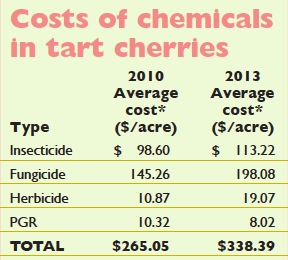
Emily Pochubay is the new Michigan
State University fruit production
educator working at the Northwest
Michigan Horticultural Research and
Education Center near Traverse City.
The cost for chemicals to grow a crop of tart cherries averaged just under $340 an acre in 2013, up from about $265 in 2010. That preliminary information came from Emily Pochubay, the new Michigan State University fruit production educator working at the
Northwest Michigan Horticultural Research and Education Center near Traverse City. She talked to growers during the Northwest
Michigan Orchard and Vineyard Show in January.
Her survey included only five of the area’s growers, and she intends to refine her information by gathering spray records from more growers this year. The last study was done in 2010, at a time when growers were introducing new chemistry—new insecticides—that the U.S. Environmental Protection Agency considered “reduced risk.”
In her study, there was considerable range in costs as growers did not all use the same chemistries and some used fewer spray applications. For example, the fi ve growers made from three to nine insecticide applications, with an average of 7.3, at an average cost of $113.22 per acre.
In the 2010 survey, growers made an average of 5.6 applications at a cost of $98.60. With fungicides, they made from 8.5 to 15 applications, with an average of 13, at an average cost of $198.08 per acre. In 2010, they made 9.25 applications at a cost of $145.26.

*Estimates do not include time, labor, or other inputs.
(Source: Michigan State University Extension)
The numbers are estimated costs of materials only, and do not include labor and other application costs. Material costs were averages of those quoted by several chemical suppliers. When a grower did an alternate row middle application, that was counted as half an application.
Herbicide costs averaged $19.07 per acre for an average of 2.8 applications, up from 2 in 2010. The cost rose from $10.87 per acre.
The cost of growth regulators added another $8.02 per acre, and growers applied them twice to prepare the crop for shaker harvest. The 2013 cost was lower by $2.30 than in 2010.
On average, growers made 25.1 applications of chemicals (many of them as tank mixes that reduced the number of trips through the orchards), an increase from 18.85 applications in 2010.
Pochubay and Dr. Nikki Rothwell, an entomologist who coordinates research work at the Northwest station, reported that there are several reasons growers are spraying more, such as:
—Some newer products cost more.
—The banning of Guthion (azinphos-methyl), which had been a major insecticide used by tart cherry growers, forced them to shift to more expensive materials that need to be applied more often. The Guthion phaseout has been gradual, with only one application allowed per season from 2011 to the end of 2013, the last year it could be used.
—Obliquebanded leafrollers have emerged as a pest. The larvae, which are wrapped in foliage, are shaken loose during harvest and become a contaminant in the harvested fruit. Growers are now using materials aimed at lepidoptera, applying one spray at petal fall or shuck split and another just before harvest.
—More growers are using a postharvest spray to control cherry fruit fl ies that attack fruit left on the trees after harvest. Researchers have demonstrated that reducing this population results in less pest pressure on the crop the following year.
—Growers are applying fungicides longer in the season, hoping to prevent defoliation caused by cherry leaf spot. Researchers have shown that early defoliation reduces carbohydrate reserves and reduces winter hardiness.
—Weather conditions in recent years have been more conducive to cherry leaf spot, leading growers to make more fungicide sprays during the growing season.
—Spotted wing drosophila is a new pest threatening tart cherries, but growers have not as yet had to apply a different insecticidal spray to combat it. •






How long have they been spraying these poison agents on cherries ? Pesticides ( fungicides, herbicides and insecticides etc. ) are extremely harmful to our entire eco-system . Children are especially susceptible to pesticides . And it is against the law to advertise them as safe. Non-hodgkins lymphoma is known as the ” pesticide cancer ‘There are all kinds of illnesses and diseases from exposure to pesticides. We would see a significant drop if companies and people would just stop,. I don’t get the people living in this area. Vanity is more important here than the health and safety of the public. From all the toxic orchards to all the toxic lawns doused with unnecessary chemicals, the accumulation of these poisons is everywhere. We are all constantly being exposed, There’s are large trend here to kill the grass, weeds and bugs etc. But there is also a trend throughout our country where the harm these poisons cause is creating a buzz to stop these big chemical companies from causing any more harm.Go to beyondpesticides.org,panna.org,,www.pesticides.org,and” Poison in the Grass’ byNathan Diegelman A lot on my mind, Julie